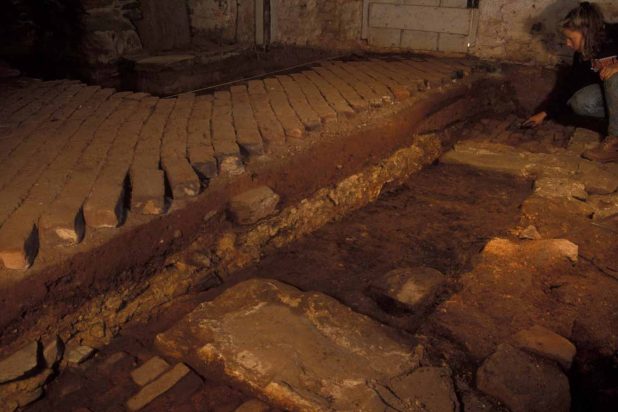Archaeology Blog
Cast of Characters Part I
Using written evidence from letters and other historical documents we begin by identifying some of the people who were involved with the construction of (and later repairs to) the wing. The details include a brief biography of the individual and their likely connection to the wing of offices.
Unnamed workers: In September of 1813, digging the wing foundation commenced. Jefferson noted in a memorandum concerning the foundation that it was dug with “6. constant diggers, 2. fillers, 2. carters who help to fill…” (TJ Weather Memorandum, September 1813, DLC). Their specific names are unknown, but it is likely these individuals were part of Poplar Forest’s enslaved labor force.
Hugh Chisolm was employed by Thomas Jefferson to be the bricklayer for both the house and the wing at Poplar Forest. His work on the wing began in April 1814, several months after the foundation had been dug in September 1813. Jefferson wrote in June of 1813, “I wish to have the work ready for Chisolm in case he gets released from military duty in time to do it” (TJ to Jeremiah Goodman, June 17, 1813, DLC). The delay, between the time of digging the foundation (September 1813) and its construction (April 1814) may have been related to Chisholm not being released from military service immediately. Upon his return in April of 1814, Chisolm traveled to Poplar Forest to work on the brickwork, but also completed the stonework for the wing foundation due to lack of available stonemasons in the local area (Chisolm to TJ, May 22, 1814, MHi).
John Hemings was born into slavery at Monticello in 1776. As a teenager, he was apprenticed to several woodworkers with whom he refined his skills in carpentry and woodworking. By 1809 John Hemings had become the master joiner at Monticello. He had been sent to Poplar Forest to work on finishing the house, and is likely to have been involved in the original roof construction for the wing (Travis McDonald, Personal Communication). Documents reveal that John Hemings and his apprentices were working on repairs to the terrace roof later in 1825 (TJ to John Hemings, August 17, 1825, MHi).
Beverly was one of Sally Heming’s sons, and nephew to John Hemings. It is possible that Beverly worked on the construction of the wing in 1814 as an apprentice to his uncle (TJ Memorandum Book, Apr 19, 1814, see Bear and Stanton (1997); Gordon-Reed 2008: 620-621). He would not have been involved with the repairs in 1825 (Gordon- Reed 2008: 621), because Beverly was listed in Jefferson’s Farm Book as a runaway in 1822 (Betts 1987: 130; Brodie 1974: 435, 473). Along with some of his other siblings, Beverly was described as being able to “pass”, meaning that he was an African-American of a lighter skin complexion, and therefore able to move into white society and live as a white person (Brodie 1974: 473; Stanton 2000: 116-117; Gordon-Reed 2008: 284, 601).
Madison, son of Sally Hemings, was apprenticed to his uncle John Hemings at the age of 14 (Brodie 1974: 475; Gordon-Reed 1997: 22). Born in 1805, Madison would probably have been too young to work on the initial construction of the wing; however, he may have been involved in repairing the wing in 1825. Regarding these repairs, Jefferson wrote to his grandson Francis Eppes who began living at Poplar Forest full time in 1823, “I will spare J. Hem. to you & his two aids and he can repair everything of wood as well or perhaps better than any body there” (TJ to Francis Eppes, Feb 17, 1825, ViU). Madison may have been one of these aids.
Eston was also apprenticed to his uncle John Hemings, and likely worked on repairs to the wing in 1825 (TJ to Francis Eppes, Feb 17, 1825, ViU). Eston would have been around 17 years of age, and was probably one of the two unnamed “aids” referenced above. Jefferson identified these two boys by name in his Codicil to his will, “I also give John Hemings the services of his two apprentices, Madison and Eston Hemings, until their respective ages of twenty-one years…” (TJ Codicil, March 17, 1826, ViU).
References
Bear, James A., Jr. and Stanton, Lucia C. 1997. Jefferson’s Memorandum Books: Accounts, with Legal Records and Miscellany, 1767-1826. Volume II. Princeton: Princeton University Press.
Betts, Edwin Morris Betts (ed.). 1987. Thomas Jefferson’s Farm Book. University Press of Virginia: The Thomas Jefferson Foundation, Inc.
Brodie, Fawn M. 1974. Thomas Jefferson: An Intimate History.New York: W.W. Norton & Company, Inc.
Chambers, S. Allen, Jr. 1993. Poplar Forest and Thomas Jefferson. Little Compton: Fort Church publishers, Inc.
Gordon-Reed, Annette. 1997. Thomas Jefferson and Sally Hemings: An American Controversy. Charlottesville and London: University Press of Virginia.
Gordon-Reed, Annette. 2008. The Hemingses of Monticello: An American Family.New York: W.W. Norton & Company, Inc.
Heath, Barbara. ND. Slave Life Brochure. Manuscript on file at Thomas Jefferson’s Poplar Forest.
Stanton, Lucia. 2000. Free Some Day: The African-American Families at Monticello. The Thomas Jefferson Foundation, Inc.
Sources of Letters
MHi : Massachusetts Historical Society, Jefferson Papers.
DLC : Library of Congress, Jefferson Papers.
ViU : University of Virginia, Jefferson Papers.
NcU : University of North Carolina, Chapel Hill, Trist Papers.
Other References
Thomas Jefferson’s Monticello: The People of the Plantation
http://www.monticello.org/site/plantation-and-slavery/people-plantation
Thomas Jefferson Papers: An Electronic Archive
http://www.masshist.org/thomasjeffersonpapers/
The Poplar Forest Department of Archaeology would like to thank The Cabell Foundation and the Roller-Bottimore Foundation for their support in funding the Wing Re-analysis project. We would also like to thank Anne R. Worrell, a long time Friend of Poplar Forest and former Chairman of the Board of Directors, for her contributions to this project as well as her continuous support of the museum.



